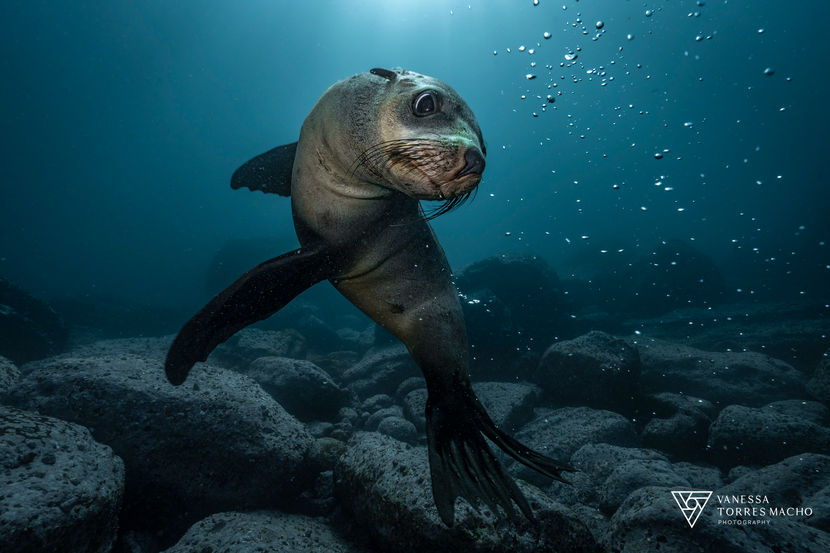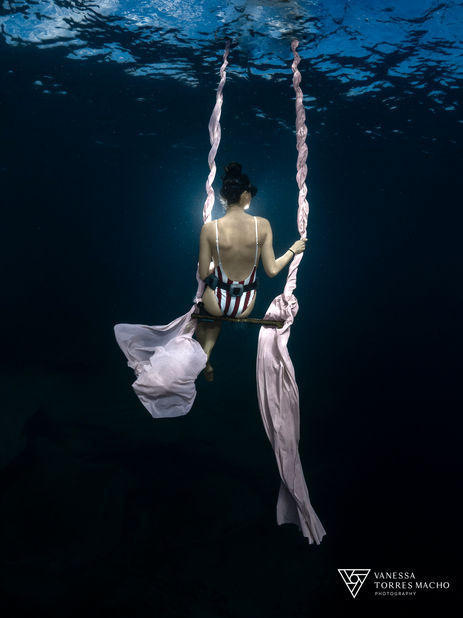Vanessa's Photo Gallery
Vanessa Torres Macho
CCP asks Vanessa Torres Macho the deep questions about her craft
1.What gets you out of bed every day?
Thinking that it’s a new day to create new imagery and closer to my next underwater expedition.
2. Who is the photographer/artist that has inspired you the most?
Simply, the photographers around me. I obviously admire great photographers who are very well known in my field but I have learnt and been inspired the most from those that I have managed to work for or with and those that share my journey. These people have either encouraged me to push and see the light at the end of the tunnel, shown me key creative ways to improve my imagery and inspired me to be better. To name a few would be Franck Gazzola, Talia Greis, Kees Beemster Leverenz, Peter Lightowler and so many others.
3. What current camera are you shooting with?
I currently own a Sony A7IV in an Isotta housing
4. When you are on a shoot do you play music? What other essential items do you have with you for a successful session?
Since I mostly shoot underwater, I generally don’t play any music, so it’s either the sound of my breathing or just the sound of water, waves or the reef.
A successful session for me usually entails the use of artificial light, even though not all my images have that, most do have strobes when I’m doing photography or video lights if I’m filming. There is of course an array of other items such as back up lights that I use as remote lighting with their triggers, my Gopro as a backup, if I’m doing macro (not very often!) a snoot to funnel the light and all my dive gear which can be as light as a pair of long freediving fins, plus a mask/snorkel, wetsuit and weightbelt to a deeper and more complex dive that can involve up to 5 tanks, my drysuit and steel backplate, a scooter and my heavy rubber fins.
Recently I’m also getting into drone shooting which happens to be the lightest equipment to carry. It always feels as if I’ve forgotten something.
5. In the digital world how important is the print?
This is absolutely crucial. First off, from a technical perspective it does give you insights on how your images look to the naked eye and then adjust when shooting next. The best part is that when I see one of my prints on paper it just fills me with a sense of purpose and that all the hurdles I went through were worth it.
I’m also a watercolour artist and there is no greater feeling than actually feeling and holding your art. In saying that, I also believe that the right type of paper can make or break a print so finding the right place that supports you and understands your vision is a huge part of that success.
6. B/W - Colour - Analogue - Digital.
Put these words in your order of preference and tell us why.
1. Digital
2. Colour
3. B/W
4. Analogue
Digital - crucial for my current situation. I’m a firm believer of waiting for the shot and creating the image before you shoot, however, sometimes I need the plasticity of being able to rely on the possibility of unlimited shots or making sure that the client is getting the image they paid for. Due to the fact that I can’t really change a roll of film underwater and sometimes I have a very small window to do the dive, digital is king for me.
Colour - there are many non divers that might not be aware that after 5m underwater, we lose most of the warm colours. Even in the clearest and most tropical waters in the world after some depth everything looks blue and green. These colours can’t be seen without artificial light, which most uw photographers and filmmakers carry with them. When shooting with a strobe, you can kind of imagine how beautiful and colourful a reef landscape looks, but it’s only when you shoot and the image pops on the screen that you get the complete image.
B&W - I’m slowly doing more and more black and white, so the only reason why it’s a third item in my list is because I have not mastered it yet. It’s actually a lot harder to excel in uw photography.
Analogue - I started my photography with film, developing images at uni and spending holidays with my little camera and a few tubs of film. Digital for me has opened a world full of possibilities.
7. Have you exhibited your work, and other than the print, how important was the framing process to you?
I’ve been lucky enough to have had my work exhibited in different locations and printed in different mediums. A frame is like the perfect ending to a good story. It rounds up and summarises your vision. If I’m printing on paper then I know that a good frame is part of the final vision.
8. What defines a great image?
I teach underwater photography so I’m going to bring this to a terrain where I feel comfortable, so amuse me in my vision of the underwater world and what can make the perfect image. If what you’re after is a beautiful and pleasant image to the eye, then I believe that composition is probably the most important factor. Now, if what you’re after is a unique image that stands above other then I refer to the Golden Triangle which takes for granted composition and focuses on unique subject, unique behaviour and perfect technical ability. We live in a great era where uw photography is very affordable and readily available through phones, so standing out has become quite hard.
9. What is your favourite photo? Why?
Uuuuuh, that is a tough one as there is not just one I could choose from. I do have some shots that I’m dying to show from a project I did in Bikini Atoll, but those can’t be made public just yet. Since we have been talking about framing and colours, I think that “Modern Flaming June’ is a shot that I never get tired of looking at. Funnily enough it was taken a bit in a rush when we were almost being kicked out of our pool session. I love everything about that image and it reminds me of a Renaissance painting.
10. What is the best photography advice you have been given? Tell us by who if you can or want to?
I was very fortunate to meet a friend who is no longer with us, a talented content creator and outstanding human being who caught me at a point in life where I was unsure if I could make the jump I wanted to do. The best advice was ‘just go for it, it doesn’t matter what other people think’. His name was Ollie and I think about him very often. Since then, I have had the pleasure to be surrounded by some talented photographers who have championed my work and keep me focused on what I need to focus on.
11. When you are not taking photos, what are you doing?
Thinking about the next photo I’m going to take or the next expedition which will get ‘that’ wildlife encounter or new shipwreck.
High Point
I’ve had a lot of highs and these have been in the water, coming out and knowing that what we have seen or experienced was unique. I have travelled to locations where I have had some wildlife encounters out of this world like in the Revillagigedo Archipelago with giant mantas and schooling silky sharks and Fuvahmulah with close tiger shark encounters. Seeing the wrecks in Bikini Atoll was a shipwreck highlight in my career and having the pleasure of participating in the Aussie movie Blueback by Robert Connolly where I got to train some of the staff in diving was an incredible experience. I hope I have many more high points in my career to come!
Low Point
I don’t think there is one, just an opportunity to improve.
Vanessa Torres Macho
May 2025

























